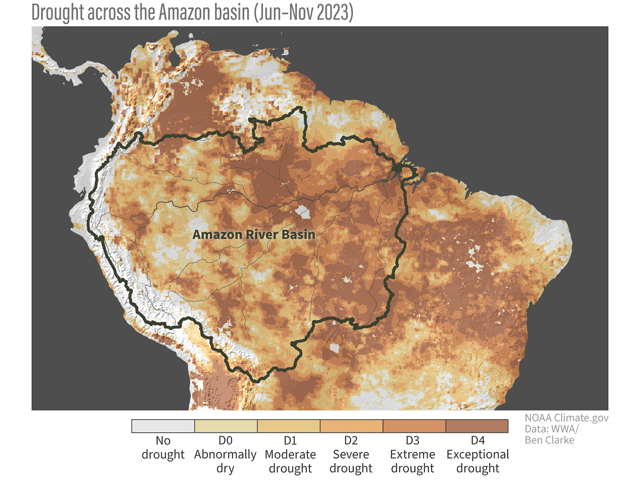Ag Weather Forum
Climate Change Kicks Amazon El Nino Dryness into Overdrive
Research into the damaging drought in South America's Amazon River basin suggests that the current drought -- a feature of El Nino atmospheric circulation -- has been worsened by the effect of climate change. The studies were done by the World Weather Attribution (WWA) project and summarized in a post on the NOAA climate.gov website by NOAA senior science writer and editor Rebecca Lindsey.
The WWA project's work, using analysis of observations and computer models, finds that, even though the 2023-24 El Nino is strong, human-caused global warming has played a greater role than El Nino in intensifying the Amazon basin drought. In terms of agricultural impact, the WWA analysis finds that rising temperatures due to climate change caused much more water stress than El Nino alone would have caused. Using the U.S. Drought Monitor scale, what would have been a "severe" drought in the Amazon due simply to El Nino's effect has been worsened by a full two levels of drought to "exceptional". That worsening of drought means that the 2023-24 Amazon drought is the worst on record.
The WWA analysis findings are preliminary and have not yet been peer-reviewed. However, the methods that were used in this study are procedures that have been reviewed and certified. In addition, many studies by the WWA project -- such as on the Pacific Northwest heat wave in 2021 and the Louisiana flooding in August 2016 -- have been published in scientific peer-review journals.
P[L1] D[0x0] M[300x250] OOP[F] ADUNIT[] T[]
The trend in warming also makes these droughts more frequent in their occurrence chances. The report notes that "The increases in drought frequency and intensity reported by the World Weather Attribution team are based on observed global warming to date, about 1.2 degrees Celsius (2.2 degrees Fahrenheit) above the pre-industrial average. Looking ahead into a future where greenhouse gas emissions continue to increase at a high rate and global warming reaches 2.0 degrees C (3.6 degrees F) above the pre-industrial, models project that agricultural droughts as intense as the 2023 event will increase in frequency by a further factor of 4, giving them an average return interval of 10-15 years."
Deforestation adds to the long-term drying impact. The report points out that at least half of the rain in the Amazon basin is actually recycled moisture that "the trees themselves inhale from the soil and breathe back into the atmosphere." The loss of trees either through planned mechanical clearing or because of fire degrades the forest and weakens the basin's rain-making capacity. Dry seasons last longer. Surface water supplies dwindle. The eventual result is a climate system that is more savanna than rainforest.
The full NOAA Amazon Drought discussion is available here:
Bryce Anderson can be reached at Bryce.Anderson@dtn.com
(c) Copyright 2024 DTN, LLC. All rights reserved.



